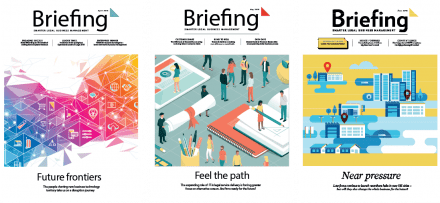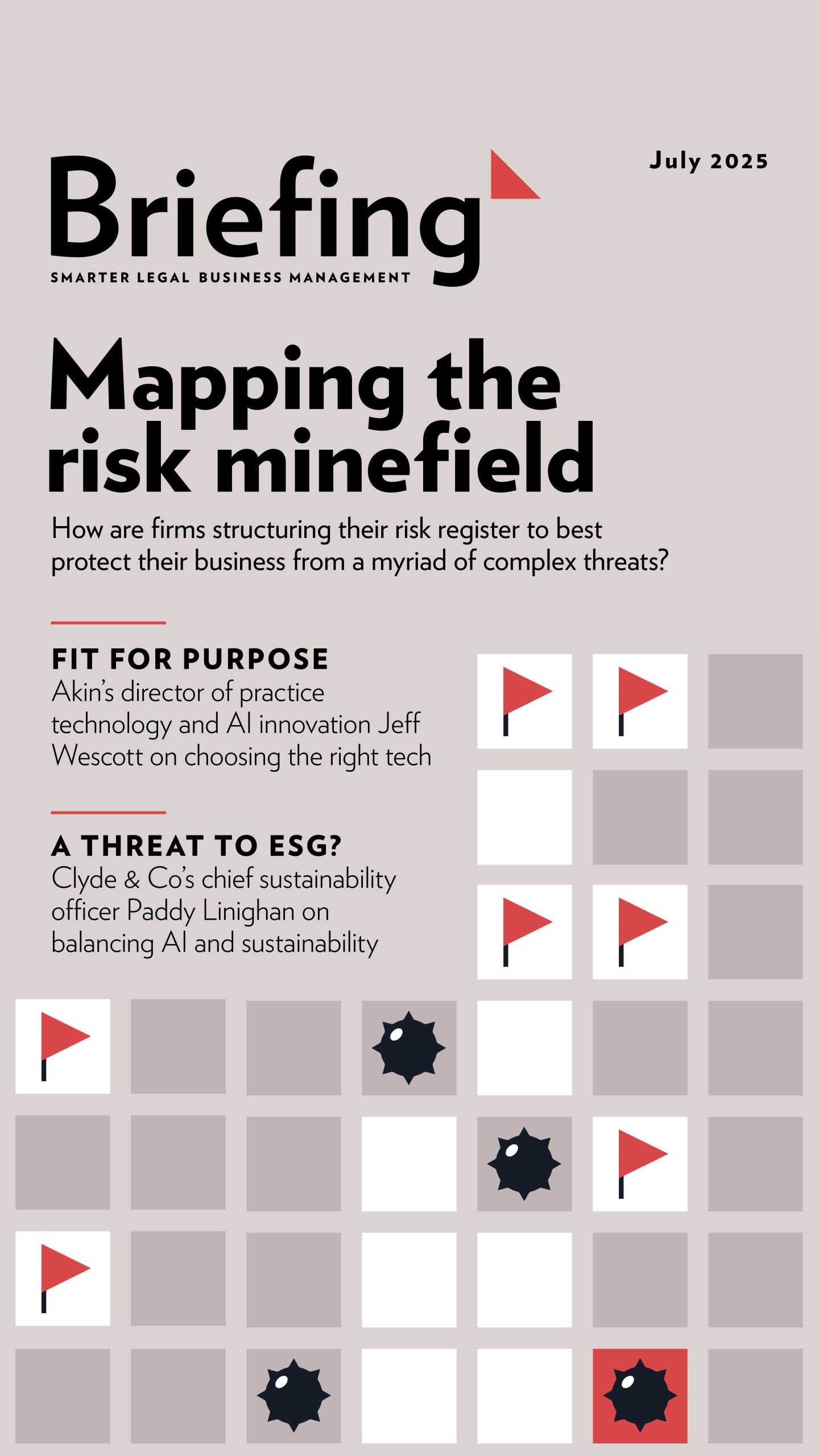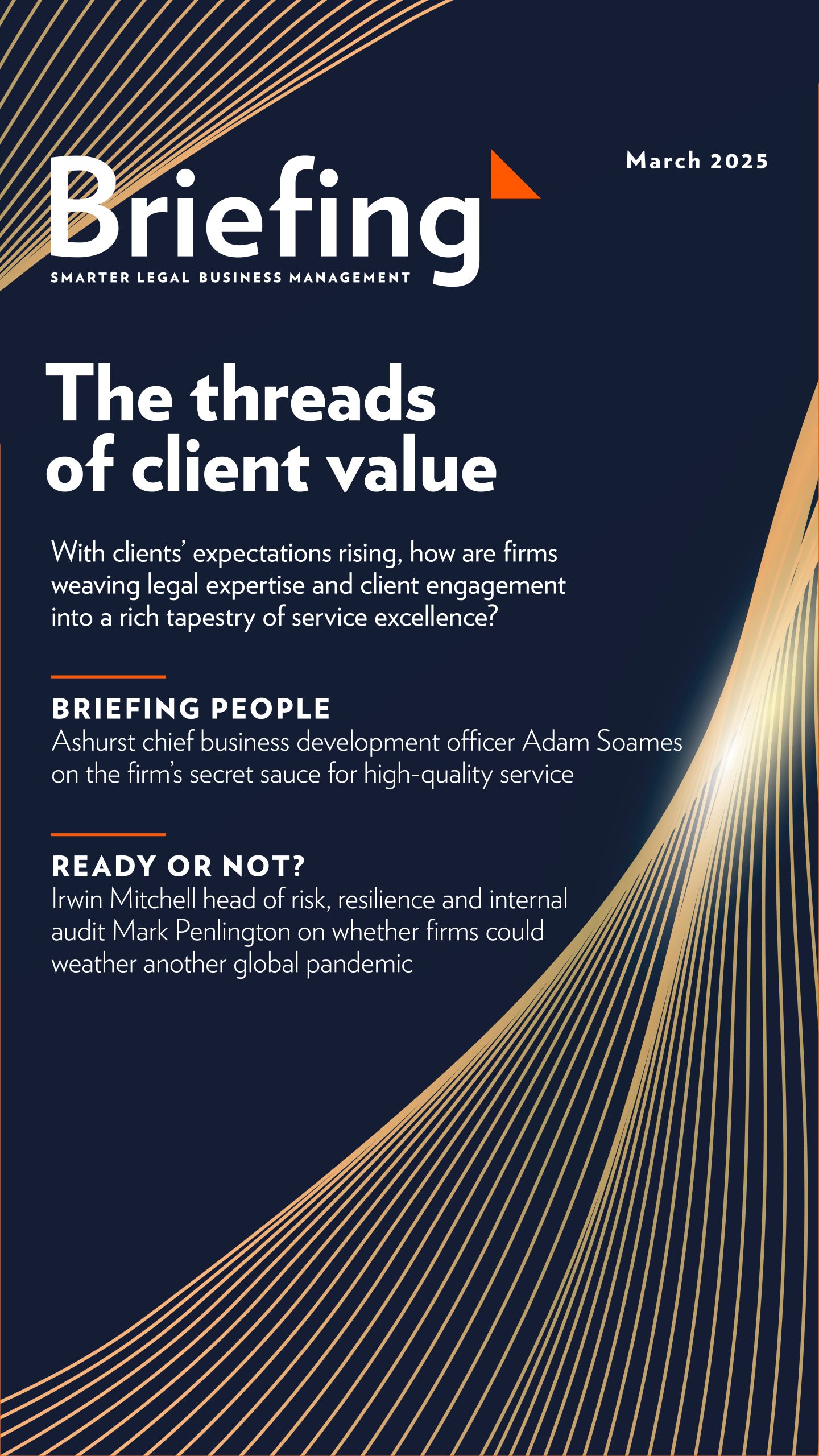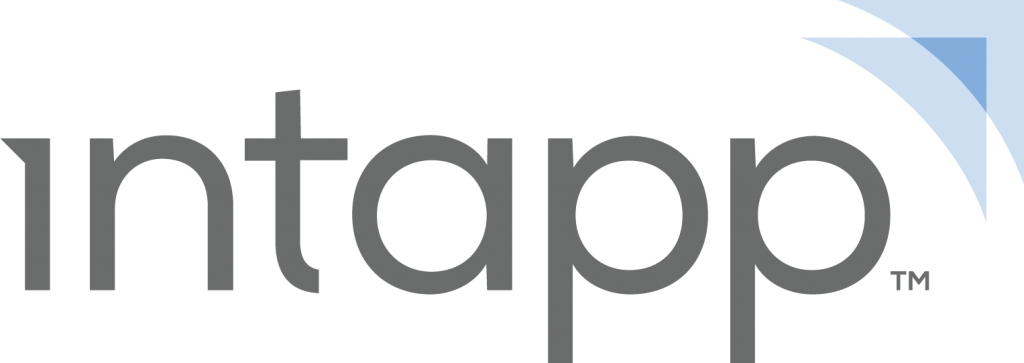
FIRST DATA — INput needed on the pitch
There’s no data strategy — or senior strategic leaders aren’t aware they’ve got one — at over two-fifths of leading large law firms that make up the Briefing audience. That’s according to this year’s Briefing Frontiers research of the cohort back in February — and it isn’t just a problem for the generative artificial intelligence (genAI) upstarts now itching to get their algorithms on the goods.
There’s marketing and business development leaders for example. At November’s big Briefing day designed just for them, over 50 joined us to tackle one super-specific management headache — selected by popular vote ahead of time. How could these stretched departments realistically streamline the process of rounding up all that credentials information needed for critical pitches that drive the business forward? Can busy and tetchy lawyers be cajoled into proactively sharing — even inputting — the information, when and where they’re meant to, under their own steam? Or does it perhaps look like a promising use case for a helpful dose of automation? Are the various data repositories sufficiently centralised or integrated —and if not, is that an achievable state?
Know — and show — your data’s worth
Many ideas put forward focused on human touchpoints — developing good process, incentivisation of ‘good’ behaviours, and carefully crafted training regimes. “Just don’t stop,” stressed one set of contributors — there’ll always be a human element, they believed — but leadership would be wise to invest time in pushing demonstration of the true value of clean data whenever they can. For example, they can highlight how significantly it reduces the rework required when completing certain tasks.
Break it down
Good advice for many a potentially mammoth project I’m sure, another group urged the room to seek out the “small possibilities” rather than trying to attack everything at once — and indeed the human enablers of those possibilities! Help here might be found right across any hierarchy or functional structure — perhaps there are some natural, but quiet, or overlooked, champions you’d want in your corner. And keep reinforcing the business drivers, they agreed — you need a clearly understandable case first when bidding for any new tech to improve a process
Truly own the issue — or get others to
There was also stressing of the right point of senior sponsorship to influence attitudes and behaviours further down the line — and important business processes inevitably need a formal owner (or owners) accountable for outcomes. Is that a lawyer or another?
Business systems may not be a solution in themselves — people, process, technology, and all that — but another table of leaders emphasised that, however sophisticated, they can’t just be left to hold and handle your knowledge. Firms also need to invest in establishing the necessary knowledge of them — maintenance and the role of matter opening, for example, as well as depositing data in accordance with a trusted taxonomy if you want a high-quality result and lasting transformation to power more productive working.
The most popular idea with the whole room, however, I’m sure can’t be as simple as it sometimes sounds. “You have to go off-piste” to persuade these busy, perhaps frustratingly resistant, people to change their ways. And what might await our leaders who take the plunge and go there? “Gamify it!”
Just say no?
CJ Anderson, director at law firm data governance experts Iron Carrot, later let us know that they also need to suffer some ‘stick’ though. Yes, there is emphasising a culture and expectation of capturing “collectively”, yes there are questions about ownership and incentivisation, and setting of good standards to consider. “But it also comes down to what you don’t or won’t do. If partners don’t feel the pain, they won’t see the problem,” she said. So if somebody asks you to fix a reporting problem that has arisen due to poor data management, it’s ok to say no: “they shouldn’t think you can automatically fix it. The perception of data as an admin exercise to be avoided simply isn’t the norm in other sectors.”
Thank you to all our event partners — ComXo, Intapp, Introhive, Litera, My Customer Lens and Peppermint — for their expert facilitation of this and several other conversations to distil the common challenges, priorities, and potential pieces of a solution. You can find many more insights extracted from all the day’s activities on the event page here.

Analysing the risk of client decline
In a fragile economic environment, law firms need to increase their focus on client retention by ensuring their relationships remain strong, diversified and mutually engaged. As soon as indicators show a decline in relations – whether through decreased revenues, slower new matter velocity or fewer practice areas engaged – firms should be developing at-risk programmes to identify the root causes of business erosion and implement remediation. Below, we recommend the key ways to conduct these programmes using data-driven methodologies and a high-touch approach to outreach and retention.
Gauging the health of client relationships
At-risk programmes provide an objective framework for firms to get ahead of business erosion, which can occur at both a macro level – affecting entire industries or practice groups – and a micro level, when specific at-risk clients disengage. Identifying early indicators of client risk is critical but, if your firm is focused on lagging indicators like revenue, you’ll likely miss problems that you could have corrected. It’s especially challenging when revenues are dependent on practices with long-running but intermittent matters, since high revenues from a single project can mask underlying issues.
To get ahead of these potential problems, examine the factors that drive revenue by analysing new matter volume and velocity, as well as time since last engagement. For example, if your billings are growing but your number of practice groups is lower, you can conclude that your revenue streams are less diversified than they could be.
Combining client feedback insights and net promoter score data can help reveal your client’s level of satisfaction. To build the trust needed to get honest, complete and actionable client feedback, client listening should be a collaborative effort between firm and client representatives
Meanwhile, a decrease in average revenues per matter might mean your client is using a different firm for higher-value work. New inquiry rates and win/loss analyses will help you understand the nature of your wins and losses. For instance, are there trends associated with practice groups, industries or geographies?
Combining client feedback insights and net promoter score data can help reveal your client’s level of satisfaction. To build the trust needed to get honest, complete and actionable client feedback, client listening should be a collaborative effort between firm and client representatives. Firms also often enlist an independent consultant or a member of senior management to help surface these critical insights.
Generally, client satisfaction is correlated with the strength of their relationship to their client team. Consequently, firms should conduct relationship mapping to identify key decision-makers, as well as continually monitor the strength of the client relationship to mitigate attrition risk if key contacts retire or otherwise move on.
Initiating conversations about at-risk clients
When you’ve identified early signs of decline, look to both the micro and macro factors to inform remediation. If you can attribute erosion to a client leadership change, other clients won’t be impacted, but if you’ve detected a pattern across a population tied to a certain practice group, the problem is likely to be systemic.
The first step is an internal conversation about why a client is at risk. Consider the sequence of those conversations, as well as who to involve. You’re looking for a mix of practice group leaders who can sponsor improvements: those who are still engaged with the client, and those who can identify growth opportunities.
At-risk programmes provide an objective, data-driven framework that can help your firm navigate the sensitivities these conversations typically surface. When data suggests an individual or team is the problem, address those concerns privately.
Making remediation decisions
Your at-risk programme should incorporate data-driven analysis on whether to save an at-risk client relationship or let it run its course. Sometimes, the problems underlying a client departure aren’t resolvable: perhaps your firm no longer performs the work that’s critical to that client or their industry position creates conflicts with a key client. In these cases, your firm may not remediate.
In any case, you’ll need to justify either intervention or status quo by assessing profitability, industry growth rate and the competitive landscape.
Building client remediation plans
Intervention requires a client conversation about recent experiences with your firm and their near-term priorities. Identify several areas where your firm can align with your client’s priorities, focusing on three critical elements: expertise, compatibility and relationships.
Start with identifying opportunities to align with the client in an area lacking a strong service provider, as it can be difficult to displace an incumbent. Select areas tied to your firm’s strategic objectives to ensure continued management support and investment.
Also consider the ancillary areas related to your specialisations: If you want to pursue an M&A matter for a life sciences company, for example, your chances are better if you have strengths in commercial and IP.
Finally, plan for sustainable succession. Keeping clients connected to your teams and introducing next-generation talent is essential for succession planning. By including a mix of seniority levels on the team you can balance the necessary management weight and support to get things done, while also seasoning more junior team members to take the reins when the time is right. By understanding your clients’ unique needs, building the right team to plan and execute your realignment, securing agreement from the client, and communicating regularly, you can keep your client relationships on track for years to come.
To find out more, visit: www.intapp.com/marketing
Richard Brent and leaders at Intapp discuss embedding deeper connections within firms
Pat Archbold, vice president and industry group leader – legal, Intapp|
Josh Clark, vice president – sales engineering, Intapp|
The period of new hybrid-working likely ahead for many will be a test of law firms’ collaborative mindsets and cohesive cultures. Will they be just as capable of keeping teams and functions focused on common goals, or will this require further investment?
But it has long been highlighted that firms would benefit from being more connected in any case. Pat Archbold, vice president and industry group leader – legal, at Intapp, says: “Firms have procured new technology as they’ve added and expanded departments, but they’ve viewed the data as independent pockets for specific purposes. They often haven’t really invested in connecting the information, and so they are missing several opportunities.
“They can also be highly focused on individual performance, which means less incentive to share data and put in the necessary work to keep it up to speed – and organising taxonomy is a long-term project.”
So lawyers, and those supporting them, can effectively be walking around with their own pockets of data in their pockets – but it doesn’t have to be that way.
Josh Clark, vice president – sales engineering at Intapp, gives one example of the advantage a more sophisticated approach can yield – understanding the spectrum of client industries and emerging opportunity within them with reference to more than current revenue achievements.
“One firm that covered real estate and also healthcare was able to identify a growing trend of real-estate clients converting shopping malls into health centres. You wouldn’t necessarily think of connecting those two. But by being closer to both industries, the firm could see the opportunity to overlay another type of experience to win business in those white spaces.”
Some are also leveraging client relationship management as a strategic shift more broadly, he explains – pulling market news about clients from external sources, for example, alongside real-time matter, time and billing information, to make recommendations about possible next steps that much more persuasively.
And alongside business development, there are some significant time savings to be made. Client billing guidelines can often be largely lost in bulging document management systems. “Some firms have an entire team to support on searching and reviewing pre-bills,” Clark continues. “However, integration of technology here can reduce the administrative burden, as well as a lot of complaints, and the likelihood of lost experience related to matters that could be leveraged for further client development later.”
Connecting with cloud
So what would a firm that delivered in a more connected fashion need from its technology? It’s notable that in late 2020 Intapp announced it would now sell its range of software as cloud solutions only (while maintaining support for on-premises versions).
Clark says: “Firms have been in business a long time – they’ve introduced a lot of technology in that time – so there is a bit of effort in moving to the cloud. But once achieved, costs erode with complexity. Bespoke comes at a cost.” For example, one firm with an industry-focused strategy such as was mentioned earlier identified a need to integrate its intake programme – getting early sight of any potential conflicts or profitability indicators – with its client development. The risk platform is therefore now moving to the cloud for that level of integrated clarity.
“The legal industry is a little behind others in cloud adoption – the conversation needs to happen firm by firm as they each have their history,” continues Clark. “But those that move to the cloud faster really can leapfrog the competition by integrating their data more effectively in that environment.”
Archbold adds that client and employee expectations of their firms is another case to consider here. If you’re investing in new teams of skilled data scientists to expand your revenue opportunities, you don’t want them to be wasting their time pulling data together – which the cloud could manage much faster.
“It makes for a much more productive data-management strategy, and as people can now increasingly work from anywhere, they won’t necessarily keep waiting and stick around. Leadership needs to think carefully about that as talent-chasing in the market continues to heat up.”
Artificial intelligence could in fact have some role in preserving a more connected firm here, he adds – not just by pushing increasingly more relevant updates out to people, at the right point in their working day, faster, but also spotting signs that a client – or even partner – may be preparing to move on to pastures new.
And finally, whichever datasets people are drawing on to play their individual parts better, the last 18 months have clearly highlighted the value of collaborative process to the connected whole.
Clark explains: “You see collaboration on proposals, matters, time and billing, concerning clients, and also with the client directly. Everyone is a part of a team, however distributed, and most likely in multiple teams. Each one needs allocation of all the right people, with the right access to the right applications and documents.
“That could mean chaos and confusion for management, but the provisioning of Microsoft Teams is a major player in bringing clarity.”
Indeed in summer 2021, shortly before its IPO, Intapp announced the acquisition of Microsoft 365-based creator of content and collaboration tools Repstor – designed to enable such governance frameworks for various work lifecycles, while at the same time enriching collaboration with more context from other connected systems.
Law firms will all need to keep people collaborating effectively – however their working patterns may change. But alongside the delivery of high-value data and empowering hard-won talent, the extent to which they do so could be yet another slice of competitive edge that marks out the more connected firm of the future.
Want to watch the interview on Youtube? Click here.
Virtual event: Briefing Frontiers 2020: Closer to clients with Intapp
Natalie Salunke, outgoing head of legal|Fleetcor
Gareth Thomas, practice group lead, marketing and BD practice, EMEA|Intapp
There’s never been a more important time for law firms to show support and demonstrate genuine value to their clients. Briefing Frontiers: Closer to clients took place as a virtual event on 21 May 2020. The virtual event explored how firms can better align themselves to client needs, and foster stronger relationships.
Webinar agenda:
- Welcome and introduction
- Insight interview – take a walk in your client’s shoes
- Gain a first-hand insight into how law firms should be engaging and supporting clients in challenging times, their expectations and how to create a better set-up for the future
- Intapp’s perspective – panel discussion and Q&A
- Your questions answered, and ours, by the Closer to clients panel
Speakers:
- Richard Brent, editor-in-chief, Briefing
- Gareth Thomas, practice group lead, marketing and BD practice, EMEA, Intapp
- Natalie Salunke, outgoing head of legal, Fleetcor; previously European GC, Enterprise Rent-A-Car; senior counsel, Netsuite; GC and company secretary, Venda
Webinar time: 1 hour.









